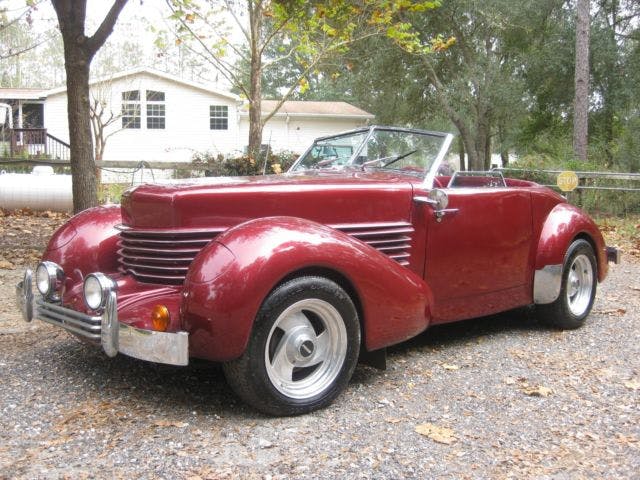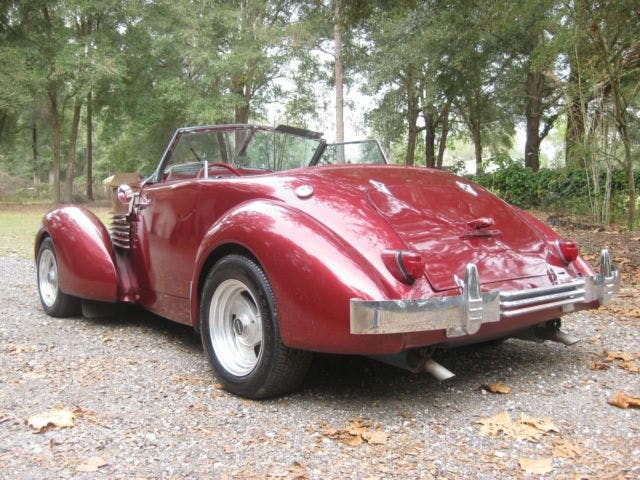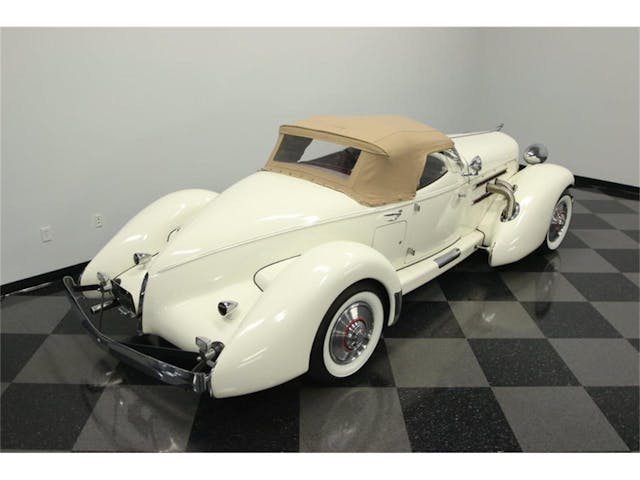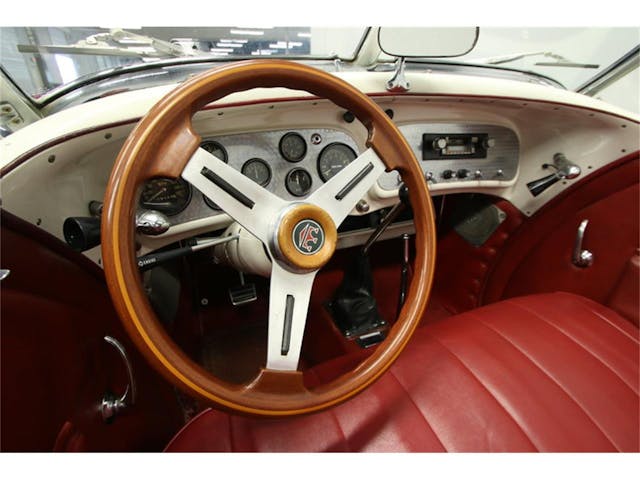Media | Articles
Glenn Pray Lost Everything to Keep Auburns and Cords Alive

What do all of these things have in common?
- The Low Volume Motor Vehicle Manufacturers Act that allows the sale of up to 325 vehicles per year that are replicas of cars built at least 25 years ago
- High-dollar “continuation” series production of legendary historic models from Jaguar, Aston-Martin, Bentley, and Land Rover by their respective factories
- Pur Sang’s recreation of the Bugatti 35, which is so accurate that owners of real Bugatti 35s use its engine to go vintage racing
- The Veyron, Ferdinand Piëch’s ego exercise in reviving the original Bugatti brand.
- Restomods—classics from the ’60s through the ’90s that are upgraded with modern drivetrains, brakes, suspension, and creature comforts
- GT40s built by Superformance and Race Car Replicas, along with copper and aluminum Cobras from David Kirkham
One could argue that none of those things would exist if it were not for Glenn Pray, an industrial arts schoolteacher from Oklahoma. In the early 1960s, he got the idea to buy a factory full of new-old-stock parts and ended up successfully reviving not just one, but two storied automobile brands.
While Pray’s company wasn’t successful by the standard of other automotive startups like Tesla—he ended up making hundreds, rather than thousands, of cars—collectors continue to value his vehicles, and they fetch as much as six-figure prices at auction. Pray also established a successful family business keeping classic cars on the road that is now into the family’s fourth generation.

Speaking of generations, that’s part of the phrase Pray used to identify the vehicles he built under those two revived brands, Cords and Auburn. Although Pray is often regarded as the first maker of replicars, he avoided the term, because he associated it with cheap knockoffs. Pray’s “second generation” Cords and Auburns had more than just an air of authenticity, largely because Pray’s Auburn Cord Duesenberg Company, which continues to operate in Broken Arrow, Oklahoma, is the direct corporate descendant of the automotive trinity originally founded by E. L. Cord in Auburn, Indiana.
When Cord saw the writing on the wall and shut down the automotive part of his industrial and commercial empire in the late 1930s, the body tooling was sold off to Hupp. Other assets, including the Auburn Cord Duesenberg headquarters in Auburn, Indiana, and its inventory of spare parts were purchased by Dallas Winslow, a businessman from Michigan, who continued to sell parts to owners of those marques. Collectors referred to Winslow’s operations as “the factory.”
Marketplace
Buy and sell classics with confidence

Glenn Pray didn’t grow up in the corporate world, or even the industrial one; he was raised on a farm in Colorado. He showed mechanical aptitude early on, building his own car out of junked Model T parts as a teenager. He followed his brother into the Marines during World War II, only to get a medical discharge due to a flareup of rheumatic fever. When an aptitude test at the VA said he’d be a good shop teacher, he used his veterans’ benefits to complete a four-year course for industrial arts teachers in just two years.
Pray started teaching shop at Tulsa Central High School in 1952. Having fallen in love with the 1936–37 Cords from the first time he saw one before the war, he tasked his students with finding one for him. Surprisingly, they actually located a ’37 Cord Supercharged Phaeton—in Tulsa. The car was in pretty rough shape, but Pray managed to restore it, and it became his daily driver. The ’37 Supercharged Phaeton was the first of a dozen Cords he would acquire over the next few years. In the process, Pray became an expert on the marque and an active part of the Cord collector community.

Glenn Pray’s “aw shucks” manner rather obscured the fact that he was a very smart, clever, and ambitious businessman. In 1960, Pray got word that Dallas Winslow was interested in selling the Auburn Cord factory in Auburn, Indiana, along with a warehouse full of OEM Auburn, Cord, and Duesenberg parts. Pray inquired about the price for the parts and intellectual property rights: $75,000, Winslow told him. That might not sound like much today, but adjusted for inflation, it’s nearly $800,000—well beyond the means of a public school shop teacher. Even so, Pray scheduled a meeting in Auburn to negotiate the purchase. To put on a good front, Pray asked a friend with a Lincoln Continental to drive him to Indiana. The driver’s side of the Continental had been damaged in a crash, but they figured they’d simply keep that side of the car out of Winslow’s view. For gas money, Pray borrowed funds from the school’s parent-teacher association. As he didn’t have money for even the cheapest motel for himself and his friend, they drove non-stop in both directions.
Not only did Pray persuade Winslow to agree to sell him the inventory of parts, but he also convinced the wealthy businessman to finance the deal. Pray sold his beloved ’37 Phaeton to make the down payment.

Pray struggled to raise money to pay off the loan, but while selling an L-29 Cord at an auction, he met a wealthy Chevy dealer and collector named Wayne McKinley, who agreed to back the venture in exchange for a 49 percent share of the company. Using one truck belonging to the dealership and another that McKinley arranged to borrow from one of his customers to use on the weekends, Pray transported 700,000 pounds of parts—in their original wooden bins—from Auburn to a ramshackle former pickle factory in Broken Arrow, Oklahoma, that Pray had leased and minimally repaired.

Pray had some rough times after acquiring all of those new-old-stock parts and even took loans from customers in exchange for the promise of parts in the future. In July of 1961, the company barely took in $200, but things eventually turned around. By the mid-1960s, the company was grossing between $6000 and $8000 a month in parts sales. To promote those sales Pray offered customers “factory” tours. When stocks of NOS parts dwindled, Pray had accurate reproductions produced.

Having achieved more stable financial footing, Pray embarked on an effort to revive the Cord brand with an all-new automobile. He enlisted the help of Gordon Buehrig, who designed the original Cord 810/812 and was working for Ford Motor Company. Pray’s original concept was a modern car with styling cues from the 1930s Cords, but Buehrig convinced him that a retro design closer to the original would likely be more successful.
Buehrig sculpted a 1/8 scale clay model in his home studio that looked very much like a Cord 810, only about 20 percent smaller and with a slightly different rear end. Playing on the model number of the original, ’36 Cord, and the fact that the new car would be about 80 percent the size of the original, Pray decided to name his new car the Cord 8/10 Sportsman.
When Beuhrig informed Henry Ford II of his side project, the chairman of the giant automaker indicated that he had nothing against Pray but that he didn’t want Buehrig’s name to be associated with the revived Cord, and he wouldn’t let Pray have access to the dimensions or drawings of the model Buehrig had made. Buehrig did, however, let Pray take detailed photographs of the model. The final styling and shaping of a full-sized clay model was done by Stanley Bromm who had worked with Buehrig at Ford and had been chief modeler of the classic 1956 Continental Mark II.

Bromm got involved because he was then working as a designer for the consumer and industrial products division of the U.S. Rubber Company, later renamed Uniroyal. The tire maker had developed a new composite body material named Royalite to compete with fiberglass. Royalite was a sandwich made of two sheets of solid ABS plastic and a core of ABS foam. When heated to 300 degrees Fahrenheit, the foam would expand and the solid sheets would soften, allowing the Royalite to be vacuum- or blow-molded into shape. Despite the fact that the material was highly resistant to impacts and dents, U.S. Rubber had had only modest success marketing the material and was looking for more publicity.

Gordon Buehrig was then in charge of researching alternative materials at Ford and one of the ones they had tested was Royalite. Serendipitously, in the summer of 1963, George Callum, the head of U.S. Rubber’s plastics division, happened to call Buehrig when Pray was in his office. Buehrig acted as a matchmaker. Callum quickly realized that the revival of the storied Cord brand was exactly the kind of publicity Royalite needed. After some meetings at U.S. Royal’s headquarters in Indiana, the company made Pray the proverbial offer he couldn’t refuse. U.S. Royal would not only cover the cost of producing the molds and tooling necessary to make Cord bodies, potentially Pray’s largest expense, it would also have Bromm sculpt the full-size clay model from which they pulled the molds.

In production, the front and rear clips were molded as one piece, later to be separated at the Oklahoma factory. U.S. Rubber wanted to be able to nest the bodies for more efficient shipment so Bromm initially gave the panels some “draft,” which would also make it easier to release the body parts from the molds. Pray, however, was adamant that the Cord’s tucked-under lower panels should remain, and they did.
U.S. Royal committed to supplying 100 bodies. It also took on much of the promotional load for the car, even publishing a brochure titled “The Indestructible Cord” and demonstrating Royalite’s durability by literally driving a car through a brick wall. The publicity campaign was a big success, way out of proportion to the size of the venture.

To source and supply the drivetrain, Pray relied on his skills as a salesman and Wayne McKinley’s connections at General Motors. Today, front-wheel drive is ubiquitous but developing a FWD drivetrain in the early 1960s was a challenge, particularly for a shoestring operation like Pray’s. He settled on using the drivetrain from the rear-engined Chevrolet Corvair, because its driveshafts were compatible with a FWD setup. McKinley arranged a meeting between Pray and the chief engineer of Chevy, and they struck a deal for engines and transmissions, including warranties and liabilities. In addition to GM’s cooperation, a number of automotive suppliers bent their rules so that Pray could buy comparatively tiny quantities of parts.

The newly incorporated Cord Automobile Co. built an assembly plant in Tulsa. While the ACD parts company was a partnership between Pray and McKinley, the new firm had investors. In late 1965, the revived Cord went on sale for $4450, a figure that turned out to be unrealistically low. As production started up, the investors wanted to fix things in place, but Pray still considered the new Cord and the new factory to be works in progress. Conflict with the board of directors grew, and after only two production cars were completed (six prototypes were made by the ACD Company), McKinley was given the task of telling his friend that he had to go. Pray agreed, providing McKinley turned over his 49 percent of ACD to Pray.

Production continued at a slow pace. The price of each car was raised to almost $6000 but the company was still bleeding cash. In 1966, the July 4th holiday weekend stretched into a plant shutdown after just 91 production series cars were assembled. McKinley tried to find an angel investor, but his efforts were in In March 1967 the assets were liquidated in a bankruptcy sale. Some of those assets ended up going into the regrettably styled, rear-wheel-drive SAMCO Cord, about which the less said, the better.

Pray went through a period of depression, and he and his wife separated. To break out of his depression, Pray got together with the Cord Automobile Company’s former chief engineer to make a full-size reproduction of the boat-tailed Auburn Speedster 866, one of the iconic automobiles of the 1930s. Starting with the frame and suspension from a Ford Galaxie, they made some modifications, stretching it to match the Speedster’s 127-inch wheelbase, shortening the overhangs, and making a removable crossmember to allow access to the oil pan. They disassembled Pray’s personal 1936 Speedster and used the body panels to make molds for fiberglass reproductions, which were mounted to a birdcage structure atop the frame. Ford initially sold him frames and drivetrains directly but an Oklahoma Ford dealer got wind of the deal and complained about Pray’s discounted prices and special treatment. Pray had to buy through the dealer, significantly increasing costs.

The first second-generation Auburn Speedster was delivered in April 1968 for the price of $8450, though that would go up $1000 by the end of the year. Eventually the price would rise to $28,650 by 1981. Again, publicity was substantial and Pray delivered finished Speedsters to celebrities like the Twilight Zone’s Rod Serling and King Hassan II of Morocco.
In 1971, Pray decided to start offering complete Auburn Speedster kits, minus drivetrains. While it was a successful venture, he rued the decision later as it made it possible for copycats to make molds off of the body panels. At one time there were two dozen companies making “Auburn Speedsters” copied from Pray’s parts. He ended up spending over $100,000 defending his trademarks on the brand and model names. One advantage that he had over the forgers, though, was the fact that he still owned the original “factory” and had access to all those NOS parts, so Pray’s Speedsters always had some authentic Auburn parts, like door handles and other trim. Another advantage was that Pray was a stickler for quality. The build quality of many of the copies was abysmal.

In 1981, when production ended, 138 Glenn Pray Auburn Speedsters had been built. An additional 18 dual-cowl phaeton versions, designed by Glenn’s son Doug and designated the Auburn Speedster 874, were also built at a starting price of $60,000 in 1974. To protect the design from copycat replicar builders, Glenn Pray filed for a design patent.

As with the Cord 8/10 Sportsmans, the Glenn Pray Auburns typically fetch mid-to-high five-figure prices when they come to auction.
In 1979, Glenn Pray had a heart attack, requiring bypass surgery, and he decided to retire for health reasons, though he finished three more cars after he retired. He also built one Duesenberg Model J replica. He was a treasured member of the Auburn, Cord, and Duesenberg communities until his passing in 2011.

The Auburn Cord Duesenberg Company still exists in Broken Arrow, now run by Glenn Pray’s grandson Adam. The company still sells OEM ACD parts, though the heart of the business is concours-level restorations of Auburns, Cords, and Duesenbergs. When I recently spoke with Glenn’s son Don Pray, he said that there were currently eight Cords getting restored and that approximately 350 vintage cars have passed through their shop. The firm also services Lycoming engines, another part of E.L. Cord’s industrial empire. The shop employs more than a dozen people and may have as many as three dozen classic Cords and Auburns undergoing restoration or service at any one time.

In 2018 the ACD Company introduced what it calls the Auburn Speedster G3, a third-generation car. Unlike the Ford-based, second-generation Auburn Speedster, the new car is based on the original 1930s Speedster, using OEM and reproduction parts. The G3 is not completely original, though. As Doug Pray told an Oklahoman newspaper, “The problem with a 1935 new car with 1935 parts is they drive like a 1935 car. What we are doing is upgrading the engine from 150 horsepower to 250 horsepower with a new supercharger, aluminum billet pistons and rods, along with improved brakes and steering.”
So far, one G3 has been completed and two more are under construction.
The asking price for the Auburn Speedster G3 is $750,000, exactly ten times what Glen Pray paid for all those parts all those years ago. I bet the old shop teacher who sold his own cars to finance that purchase would smile at the thought. If you’re driving a restomod, a replicar, or a continuation series vehicle, the thought of Glenn Pray should bring a smile to your face as well.







A story I have heard but not in as much detail. This was a great story.
GREAT article!
“…car was in pretty rough shape, but Cord managed to restore it, ” — you meant “Pray”.
that was the fault of the editor — fixed! thanks.
Very interesting story. I would truly love to own a coffin nosed Cord. I remember my dad telling me about one for sale years ago in Maryland when he was looking for a car but he ended up with a Kaiser-Frazer Golden Dragon. Would love to have one of those also.
There is a Cord 8/10 in a neighboring town, I occasionally see it at the local restoration shop. I’d love to have it and have told the shop owner to contact me if the owner tires of it.
Another bass owned for years by A local police officer. I’d see it in front of his beautiful home. Later he has an original Auburn Convertible Sedan…basically a four door Speedster with the same front end.
Incredible story. He put everything on the line.
Very cool story. I learned a lot on this. Did not know they had a presence in Oklahoma even today.
Great story. Let me add that if you have not visited the Auburn/Cord/Duesenberg Museum in Auburn, IN you should seriously consider doing so. Located in the original factory building, it is a fantastic collection of classic ACD’s, plus a few from other makes.
Allocate two days if you do go. One day really won’t do it justice. Thanks for the informative and interesting story.
I had and liked a ’66 Glen Pray Cord 8/10, like most white with a red interior. Looked great and drove OK. The drivetrain was a Corvair engine and transaxle mounted in front but backwards for balance with the ring gear reversed so it had 4 speeds forward while sitting 180 degrees from the direction of operation in a Corvair. The only difficulty was getting a front end alignment as it pulled to the left. The shop had to physically bend some front suspension pieces to align it as it was a bit cobbled together. But a real conversation starter. The Royalite finish held up well and was truly dent resistant but like plastic fenders on many modern cars it may have cracked when cold and brittle in winter.
The lead photo is of an Auburn Speedster, not an 8/10
It certainly is, we have made that correction. Thank you.
Nice article I am the current owner of the cord in the pictures .I am in the process of refurbishing the interior .It
Does not have a top or top bows(top frame) and I have not been able to find one .Any help ,leads would be appreciated .FWilliamPeterson@gmail.com .
Auburns and Cords have been favorites since my first view of each one years ago. Beautiful automobiles and worthy of preservation. Thank you for the informative and interesting article. Much appreciated.
I live about 100 miles south of Broken Arrow Ok where the old pickle factory/auto manufacturing plant of Glenn Pray’s is located. I’ve been retired for nearly a decade and always worked in manufacturing machine shops. As with most people, I grew completely disheartened with my occupation at several points in time. On one of these occasions in the late 90’s I had heard the window washers in downtown Tulsa were making $4 an hour and hoofed it to T-Town to check into it. As I remember, the company was based in a small building in the north part of downtown Tulsa next to a chrome shop that my brother used for the Harley choppers he built. I rode with hm up on one of his chrome trips but the window business (Clear View) was closed that day and I never went back.
Another occasion in which I wanted to change my employment was a few years later in the early 70’s. I’d heard of Gelnn Prays endeavor on the Cords and then the Auburns and i made a jaunt up to the pickle factory. When I pulled up in front of the business, first thing I saw were two old fourdoor Cord sedans with no suspensions sitting in the lot just north of the business. Weeds were grown up knee high and the cords looked like they had been there for years. Went in and there on the sort of a showroom floor was a new Auburn Speedster (looked just like the one in the article) and a beautiful very early 1900’s Buick. I stated my interest in seeking employment and was told that Mr. Pray was not going to be at the business that day. They did let us look around parts of the business and I recall a raw body shell of an Auburn Speedster still in the build jig in one area of the shop. I never went back and ended up retiring from Boeing many years later. Wish I’d taken pictures that day.
Something not mentioned in the article is that the standard Cord engine was to be the 4-carb 140hp Corvair. But optional was the 180hp turbocharged engine from the Corvair Corsa. When you got the turbo engine, you also got the outside flex-pipes that supercharged Cords and Duesenbergs had. Only on the passenger side, tho. As a Corvair guy, I knew about Glenn Pray, but never to this level of detail. Great article!